An SEO strategy is essential for enhancing a website’s visibility for both Google crawlers and users. It plays a key role in digital marketing. Within an SEO strategy, we can divide actions into On-Page and Off-Page SEO. While they may seem similar, they address different aspects, both on and off a webpage.
If you’re new to digital marketing and want to start with an effective SEO strategy, this guide is ideal for you. We’ll begin a long journey that will, by the end, have enriched your knowledge far beyond what you knew at the start.
What is an SEO Strategy, and Why is It Important?
An SEO strategy (Search Engine Optimization) is a set of actions and techniques applied to a website to improve its visibility in search engines, with the goal of attracting quality organic traffic that aligns with the target audience.
This strategy is crucial in digital marketing because it helps a website rank higher in search results, increasing the likelihood of being found by users without the need to pay for ads. Over time, this reduces costs associated with ads and paid media.
The true importance of SEO lies in increasing your website’s visibility, credibility, and authority. To learn more about SEO’s impact, we invite you to read this article explaining what SEO is and how it works.
On-Page SEO vs. Off-Page SEO
If we picture SEO as a tree, there’s a clear, initial split between two main branches of website optimization: On-Page SEO and Off-Page SEO.
Local SEO: What It Is and Why It Matters
Another essential branch is Local SEO, which focuses on boosting a business’s visibility in geographically specific searches. It aims to attract potential customers near the business’s physical location by optimizing elements like local keywords, Google My Business, and local reviews.
Local SEO is crucial for businesses that depend on geographical proximity to drive sales, like restaurants, physical stores, and local services, as it increases the likelihood of being found by users searching for products or services “near me.”
Steps to Create an Effective SEO Strategy
Creating an SEO strategy involves a series of steps to optimize your website’s presence in search engines:
1. Current Situation Analysis
The first step is conducting an SEO audit to evaluate the website’s current state. This helps identify technical errors, content issues, and areas for improvement.
I recommend tools like Google Search Console, SEMrush, Ahrefs, and Screaming Frog to detect errors such as broken links, slow load times, or duplicate content. Analyzing these factors is essential to understand the starting point and areas for enhancement.
2. Keyword Research
Remember: a solid SEO strategy is built on thorough keyword research. Use tools like Ahrefs and SEMrush, or the more budget-friendly Google Keyword Planner. This will help identify high-search, moderately competitive keywords to target a specific audience. Selected keywords should align with users’ search intent.
3. SEO Content Strategy
Creating quality content based on keywords improves SEO by making web pages more relevant to user searches. SEO content must be relevant, meaning it should provide users with the answers they are searching for in the first place.
Useful and relevant content attracts and retains users, reducing bounce rates and increasing time on site. Both factors are positive signals for search engines. Additionally, good content encourages interaction and the possibility of gaining external links (backlinks), which strengthens the page’s authority. If you want to improve the SEO of your existing content, it’s crucial to prioritize the following actions:
- Review Keywords: Ensure keywords are relevant and update those that no longer generate traffic.
- Optimize Metadata: Update titles and descriptions with keywords that reflect user intent, improving click-through rates (CTR).
- Improve Structure: Use headers (H1, H2, H3) and well-organized paragraphs so that both users and search engines can easily navigate your content.
Don’t worry; these sections we’ve briefly explained will be expanded below. Keep reading to gain more insights and see if you were familiar with some of these actions!
On-Page SEO Actions: Improve Your Ranking with Content
On-Page SEO focuses on all internal optimizations of a website, aiming to improve its visibility in search engines and provide a better user experience.
URL Optimization
URLs play an essential role in SEO and website structure. They should be clear, descriptive, and contain relevant keywords in the slug. A good practice is to keep URLs for pages and articles as short as possible and reflective of the page’s content.
For example, a URL like:
www.example.com/seo-strategies
is more effective than:
www.example.com/p123?abc
This makes it easier for both users and search engines to understand the page’s topic, improving the experience and ranking.
Internal Links
The inclusion of internal links is crucial for helping search engines crawl and understand your site’s structure. They also allow for the distribution of authority from one page to another, known as “link juice”, which helps improve the ranking of other sections on the site.
These links also enhance user navigation by making it easier for users to find related content, which increases their time on the website.
Header Structure (H1, H2, H3)
Proper header organization not only improves content readability but is also essential for search engines to understand the information hierarchy.
Using H1, H2, H3 tags, etc., which represent the main titles and subtitles of an article, is key to logically structuring content. The H1 should be the page’s main title, while significant subsections should use H2, and details within these sections can fall under H3.
Extensions are available to view this more easily without accessing the site’s HTML code. A recommended tool is SEO META in 1 CLICK, which will show you something like this:
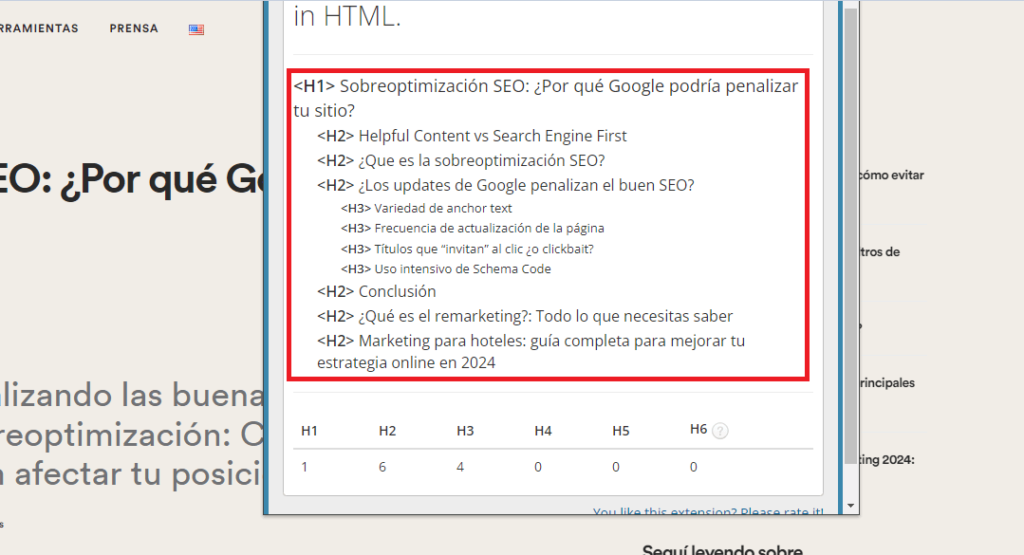
Keyword Density
Keyword density refers to how often a keyword or phrase appears relative to the total word count on a page. While it’s essential for main keywords to be present, they should be used naturally rather than forced.
An overload of keywords (known as “keyword stuffing”) can lead to penalties from Google. Ideally, keywords should be smoothly integrated into titles, subtitles, and the body text, alongside synonyms and related terms.
User Experience (UX)
User experience is one of the most important factors in on-page SEO, but why? Essentially, search engines prioritize sites that offer easy navigation, fast load times, and responsive design.
For example, if a page takes too long to load, users are likely to leave, increasing the bounce rate—a factor that can negatively impact a website’s ranking.
Google has implemented metrics like Core Web Vitals to evaluate UX, highlighting the importance of improving speed, visual stability, and site interaction.
Structured Data
Using structured data, or “schema markup”, helps search engines better understand a page’s content. Implementing this data in HTML enables search engines to present rich results in SERPs, like featured snippets, image carousels, or product information (prices, availability). This enhances your site’s visibility and can increase the click-through rate (CTR).
Here’s what a site using Schema code looks like in Google’s organic results:

In this case, it’s a product schema (structured data), which can be viewed through the site’s HTML code:
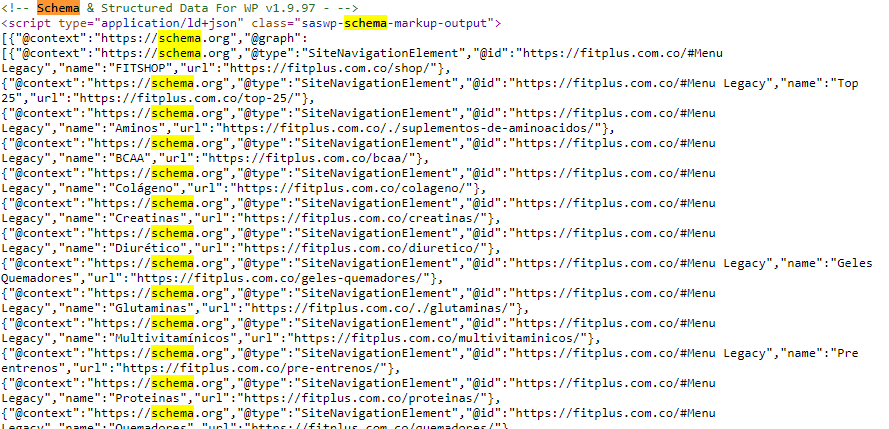
You can also view this with free tools like the schema.org markup validator, where you can see both the HTML and the Schema structure.

Off-Page SEO Actions: Strategies to Improve Your Authority
Off-page SEO encompasses strategies implemented outside your website to boost domain authority, relevance, and consequently, search engine ranking.
Quality Backlinks
One of the most important factors in off-page SEO (and SEO as a general concept) is building backlinks, also known as link building. A backlink is a link to your website from another site, also called an external link, as opposed to internal links within your site.
Search engines consider backlinks as “votes of confidence.” If a reputable website links to your content, it indicates that your page is valuable. For a well-planned SEO strategy, it’s essential to focus on obtaining quality backlinks from relevant, authoritative sites in your sector rather than merely amassing a high volume of links.
Collaborations and Mentions
Another effective strategy is to collaborate with other websites or influencers in your niche. These partnerships can include guest posts, interviews, or mentions on social media and blogs.
Additionally, digital public relations (Digital PR) can play a crucial role by generating brand mentions in online media. The more positive mentions your site receives, the more authority it builds, favoring its ranking.
Social Media Optimization
Although links from social media don’t directly impact SEO ranking, an active presence on social networks can drive more traffic to your site. If your content is shared on platforms like Facebook, Instagram, Twitter, or LinkedIn, it increases the potential to attract more visitors through these channels.
This not only generates more visibility but also improves user behavior metrics such as time on site and click-through rate, which can indirectly influence SEO. A good example of an optimized social media profile is MD Marketing Digital’s YouTube channel, which includes links to all other social networks, as well as the website, and an introduction that incorporates keywords related to digital marketing.
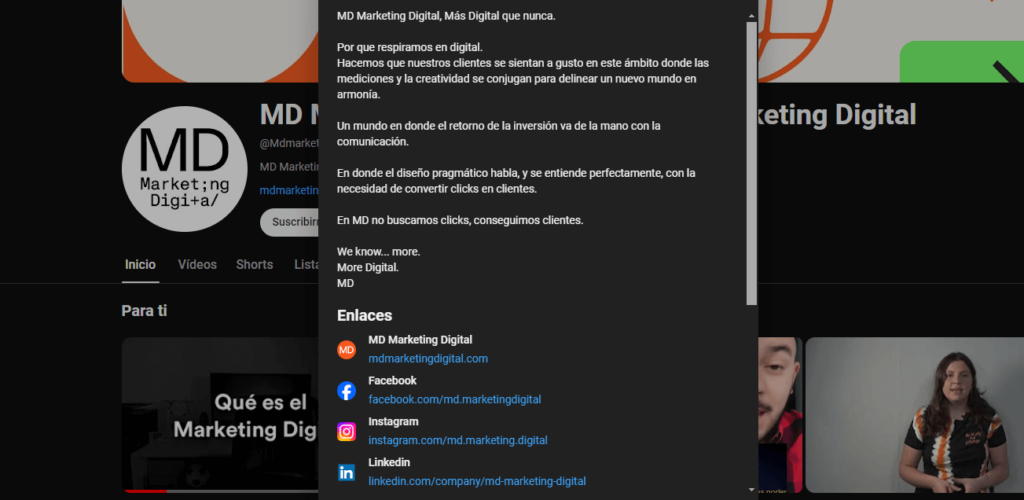
Participation in Online Communities
Being active in industry-related communities and forums can also be beneficial, especially if your website, or the one you manage, focuses on a niche. Answering questions on platforms like Quora, Reddit, or specialized blogs (such as Blogger) can help you build your reputation as an expert. By including useful links to your content, you can attract qualified traffic to your site.
Local Directories and Mentions
If your business has a physical location or provides services in a specific area, it’s essential to ensure a presence in local directories and geolocation services like Google My Business. This will not only help you attract local customers but also improve your visibility in searches related to your industry.
E-commerce SEO Strategy: Boost Your Online Store
An SEO strategy focused on e-commerce is key to improving your store’s visibility in search engines. Knowing how to optimize product listings, categories, and leveraging local SEO can significantly increase traffic and conversions.
Product Page Optimization
To help your products rank better in search engines, it’s essential to optimize their descriptions. Ensure each description is unique, detailed, and includes relevant keywords for each product. Additionally, meta titles should be clear, specific, and attractive, using strategic keywords to catch the attention of users and search algorithms.
A prime example here is Amazon, which provides extensive details for its products:
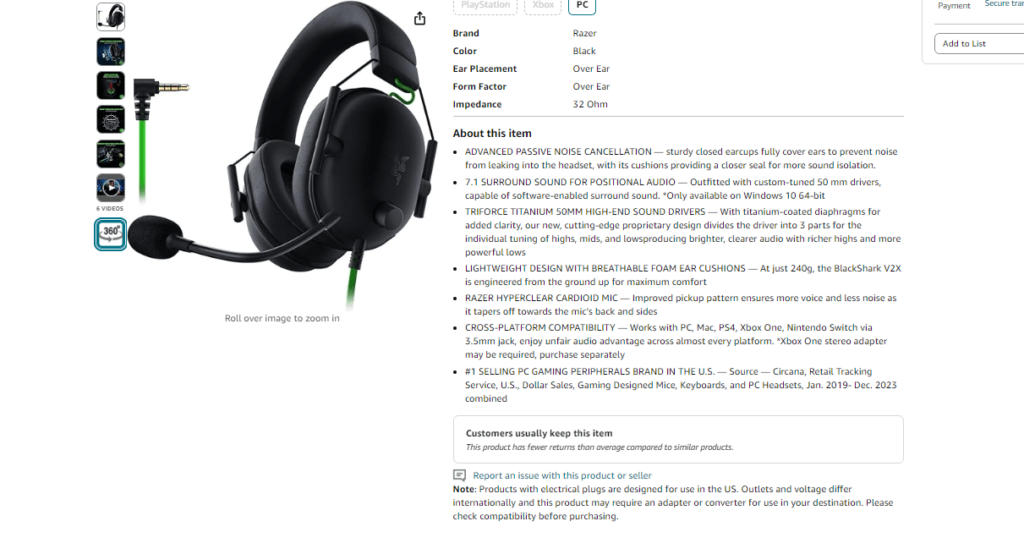
It also includes comparison charts:
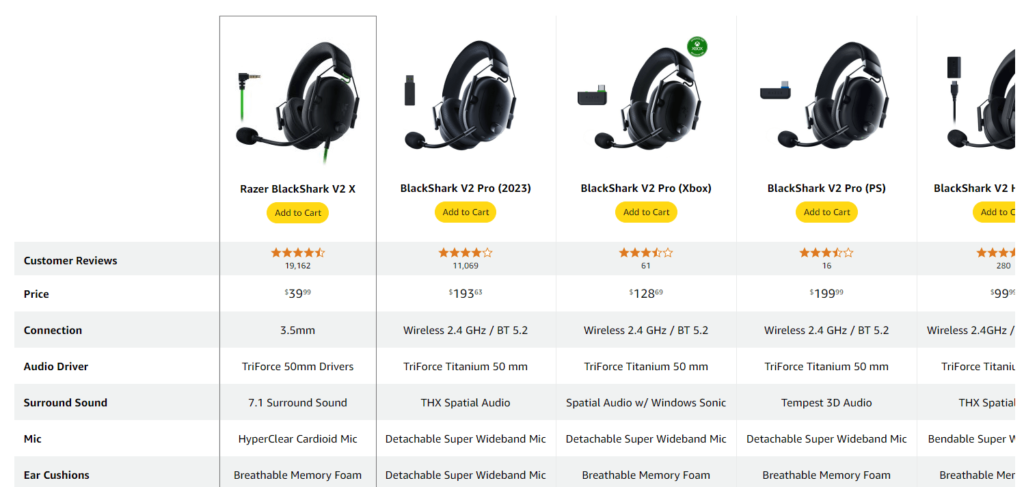
Along with these features, Amazon has large galleries with high-definition images for each brand. However, the most crucial aspect is human input: buyer reviews are what everyone notices:
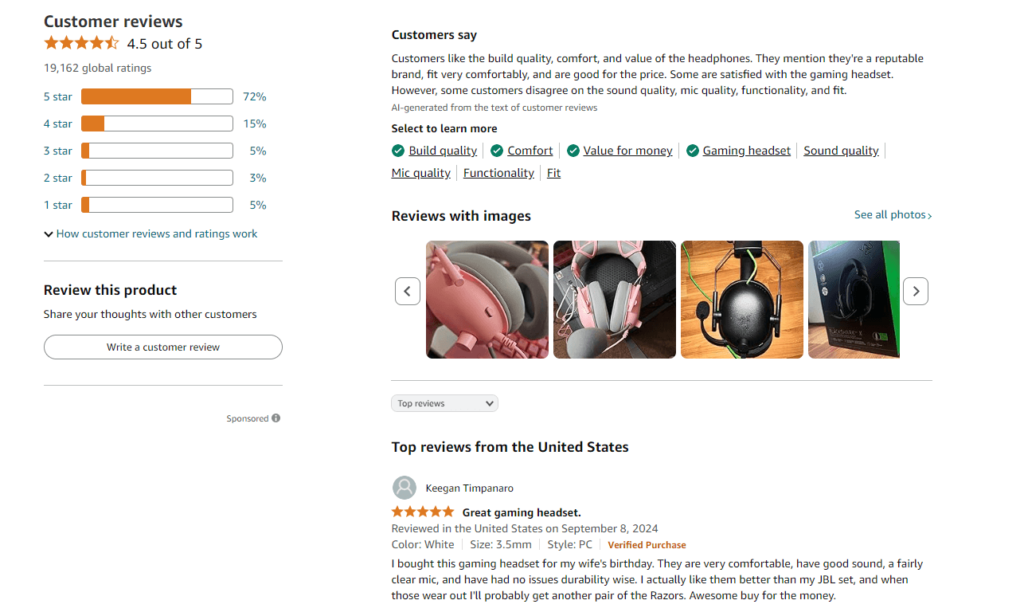
SEO for Product Categories
Category pages also play a crucial role in an SEO strategy. They should be well-organized and optimized with related keywords. Adding relevant content, like category descriptions, not only enhances user experience but also improves SEO performance.
Additionally, internal linking within your site facilitates user navigation and helps search engines index your pages more effectively.
Local SEO and Business Profile Optimization
If your store has a physical location or you want to attract customers from a specific region, local SEO is essential. Optimizing your Google My Business profile with accurate, updated information—including name, address, phone number, and hours—increases your visibility in local searches.
Encouraging customers to leave reviews can also enhance your reputation and ranking. Below is an example of the Google My Business profile for MD Marketing Digital:
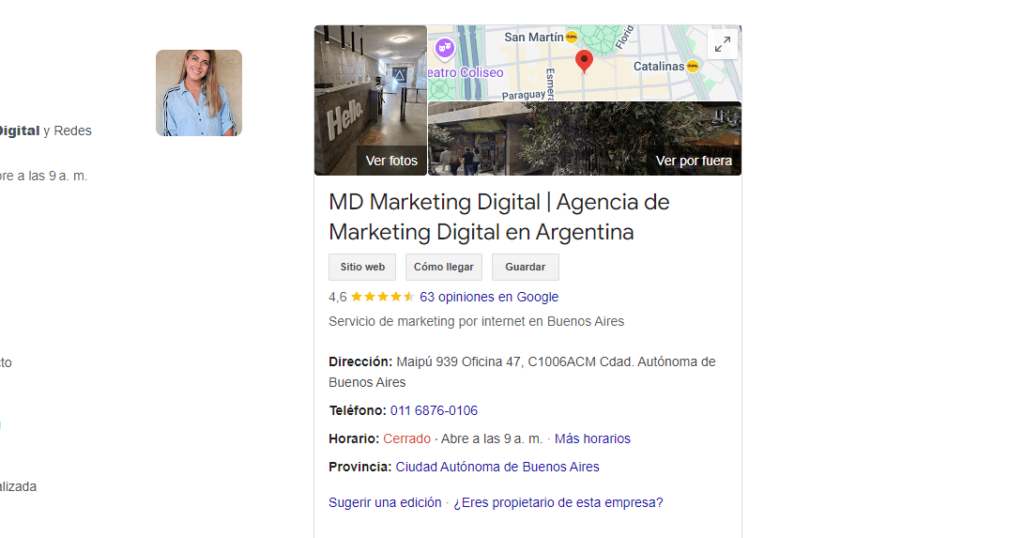
As you can see, it’s a complete profile that includes key details a typical user would look for (address, phone number, hours), along with numerous reviews and an average rating of 4.6 out of 5, indicating good service.
Advanced SEO Strategies: Boost Your Competitiveness
Advanced SEO is essential to improve a website’s competitiveness in the digital landscape. Here are some of the most effective strategies to optimize your ranking and gain an edge over the competition.
Core Web Vitals Optimization
Core Web Vitals are key metrics Google uses to measure user experience on your website, focusing on load speed, interactivity, and visual stability.
Optimizing these metrics can improve your search ranking. To achieve this, it’s important to reduce load times, improve page responsiveness, and avoid unexpected layout shifts while content loads.
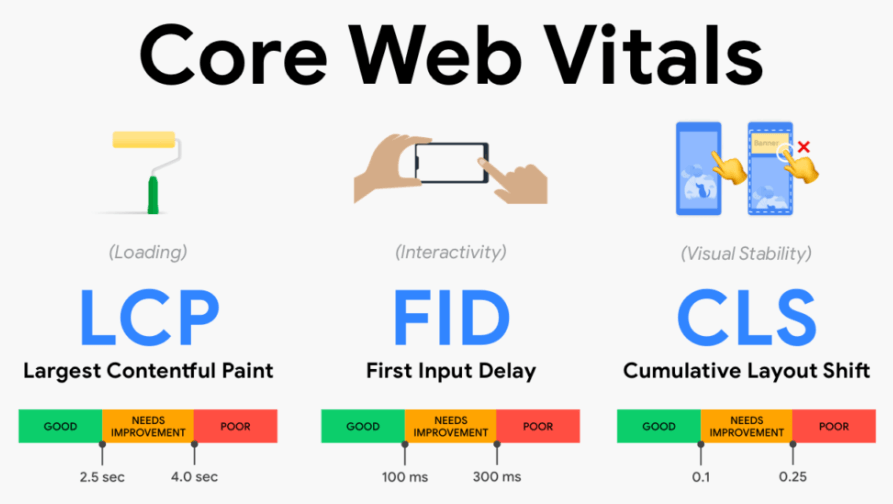
As shown in the image, some of the main metrics to consider for evaluating user experience are as follows:
- LCP (Largest Contentful Paint): measures how long it takes for the main content to load. A good LCP should be under 2.5 seconds.
- FID (First Input Delay): evaluates the time it takes for a page to become interactive after a user action. The ideal FID should be under 100 ms.
- CLS (Cumulative Layout Shift): measures page stability, specifically how much layout shift occurs while content loads. A good CLS should be below 0.1.
Improving Load Speed
Site load speed is one of the most critical SEO factors. A faster site enhances user experience and increases time on page. Tools like PageSpeed Insights can help identify issues and optimize resources like images, scripts, and stylesheets, which speeds up server response time and improves overall site performance.
Technical SEO Implementation
Technical SEO focuses on improving site structure to facilitate indexing and crawling by search engines. Actions like optimizing URL structure, implementing sitemaps, and correctly using schema tags are essential for search engines to better understand your content.
Additionally, optimizing the robots.txt file and properly managing redirects can prevent crawling errors and enhance visibility.
Tools for Developing an Effective SEO Strategy
When creating an effective SEO strategy, it’s essential to go beyond best practices and rely on specialized tools that provide valuable data for analyzing, optimizing, and measuring a website’s performance in search engines.
Google Analytics (GA4)
Google Analytics, now known as Google Analytics 4 (GA4), is a fundamental tool for any SEO strategy. It allows you to track user behavior on a website, providing key metrics like session duration, bounce rate, and most-visited pages.
With this information, you can identify which content is most attractive to visitors and which sections need improvement. Some specific features that stand out include:
- Traffic Analysis: This helps you understand how many users visit the site, where they come from (organic search, social media, etc.), and what devices they use.
- Conversion Tracking: You can set up goals (like sales or sign-ups) and analyze which paths within the site lead users to achieve these objectives.
Google Search Console
While Google Analytics focuses on user behavior, Google Search Console offers a more technical perspective on how search engines perceive your website. This tool allows you to monitor several key areas, such as:
- Monitoring Presence on Google: It shows which search terms generate impressions and clicks to your site, which is crucial for understanding if your keywords are ranking well.
- Identifying Crawling Errors: This helps you detect indexing or crawling issues on your site that might prevent Google from ranking your pages correctly.
- Improving Mobile Speed and Experience: Search Console provides reports on your site’s performance on mobile devices, a critical metric since Google highly values mobile user experience.
Ahrefs
Ahrefs is an essential tool for competitor analysis and backlink research, two critical factors in any SEO strategy. Its primary function is to analyze inbound links (backlinks) to a website since quality links are one of the most influential factors for search engines like Google. In addition, you can conduct keyword research to optimize your content strategy.
Semrush
Semrush is another comprehensive tool similar to Ahrefs and its main competitor. It offers a variety of features to cover different SEO aspects, such as keyword research with data on search volume and search intent (informational or transactional).
You can monitor competition and perform technical audits, identifying broken links, crawl errors, and recommendations for improving load speed and usability.
Screaming Frog
Screaming Frog is a crawler tool that allows you to analyze a website as a search engine would. It’s particularly useful for identifying technical issues that may affect SEO. Some of its main functions revolve around detecting broken links and analyzing metadata (showing you, for example, long titles and short meta descriptions).
With Screaming Frog, you can also analyze duplicate or short content, one of the main factors that negatively impact SEO. This is PC software, so you can download it from its official website.
Moz
Last but certainly not least is Moz, another invaluable tool, ideal for SEO planning and optimization for any site. It’s similar to Ahrefs and Semrush but with more personalized features, like Moz Link Explorer, which allows you to analyze a website’s link profile and find opportunities to gain backlinks.
Moz also offers a Keyword Explorer to assess keyword difficulty and estimated CTR, as well as MozBar, a free toolbar extension to use while browsing any website.
Common SEO Strategy Implementation Mistakes and How to Avoid Them
Implementing an SEO strategy can be challenging, and many websites make mistakes that impact their visibility in search engines. Identifying these mistakes and understanding how to avoid them is crucial for improving any SEO strategy’s effectiveness.
If you’re new to SEO, you may have encountered (or will encounter) some of these issues, but here’s good news: we’ll give you solutions to tackle them.
Lack of Updated Content
One of the most common mistakes is failing to keep website content updated. Search engines favor sites that offer fresh, relevant information. If your content is outdated, your rankings on the SERP are likely to be affected.
The solution? Set up a publishing schedule. Schedule regular content reviews to ensure all information is up-to-date. Additionally, publish new content regularly to help attract fresh traffic and boost online authority. Another useful approach is to update older posts with renewed information.
Excessive Keyword Usage (Keyword Stuffing)
Google penalizes keyword stuffing, which can lead to lower rankings or even de-indexing. A solution to this is to focus on content quality, using keywords naturally where context justifies their presence. If you need to repeat them, use variations and/or synonyms.
Failure to Optimize for Mobile Devices
With a growing number of users accessing the internet through mobile devices, failing to optimize a site for mobile is a critical error. Google prioritizes “mobile-first indexing”, which means it evaluates the mobile version of your site first to determine its ranking.
To improve your site’s mobile performance, make it responsive. This type of design adapts to the device’s dimensions, with easier-to-navigate menus, readable content, and fast load times.
Free tools like PageSpeed Insights or Google Lighthouse allow you to verify if your site is mobile-optimized.
Ignoring Analytics and Tracking
Many sites don’t use analytics tools to track their SEO strategy’s performance, limiting their ability to identify issues and improvement opportunities. To reverse this, configure Google Analytics and Google Search Console to provide insights into traffic, traffic sources, and keywords generating visits. Use this information to refine and enhance your strategy.
Periodic SEO audits are also highly beneficial. Tools like Semrush and Screaming Frog can help identify technical issues that may be affecting your SEO, such as broken links or duplicate content.
Neglecting Local SEO
For businesses that depend on local traffic, not optimizing for local SEO is a mistake that can severely limit reach. Companies without a solid local search presence risk losing potential customers. Here are some actions you can implement for positive results:
- Create and optimize your Google My Business profile: Ensure all information is up-to-date and respond to reviews. This will help your business appear in local searches.
- Incorporate local keywords: Use terms that include your location in your content and metadata. For example, if your business is in Madrid, consider including terms like “restaurant in Madrid” in your strategy.
Overlooking User Experience (UX)
User experience (UX) plays a crucial role in SEO. A website that is difficult to navigate, slow, or confusing can drive visitors away, negatively impacting metrics like session duration and bounce rate.
To improve UX, optimize your site’s load speed. Use tools like PageSpeed Insights to identify files, images, or HTML, CSS, or JavaScript fragments that may be causing excessive load times.
Another effective measure is simplifying your site’s navigation, making it more accessible and straightforward with a minimalist design.
Have You Learned How to Develop an SEO Strategy?
As we’ve seen throughout this article, creating an SEO strategy is neither simple nor quick; it takes time, dedication, and knowledge to build a plan that will increase your website’s ranking and organic traffic.
If you enjoyed this article, we’d like to ask two things: first, try implementing our recommendations and tips in your activities! And second, it would be great if you could leave a comment sharing your experiences and/or questions related to SEO strategies.
At MD Marketing Digital, We Can Take Your SEO Strategy to the Next Level
Even though you’ve learned a lot from this content, it’s completely understandable if it’s challenging to apply it all easily right away. If you have questions or need more expertise for your website, don’t worry—at MD Marketing Digital, we have professionals in the fields of Digital Marketing and SEO.
What are you waiting for to boost your site and position yourself among the best in the market? We’re here for you!
- Google Core Update: History of Major Updates - December 17, 2024
- How to Create an Effective SEO Strategy in 2024? - November 8, 2024
- Google Helpful Content Update: A History of Major Google Updates - August 2, 2024
¿Qué te pareció este artículo?
What do you think about this post?






